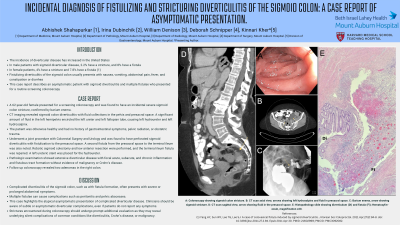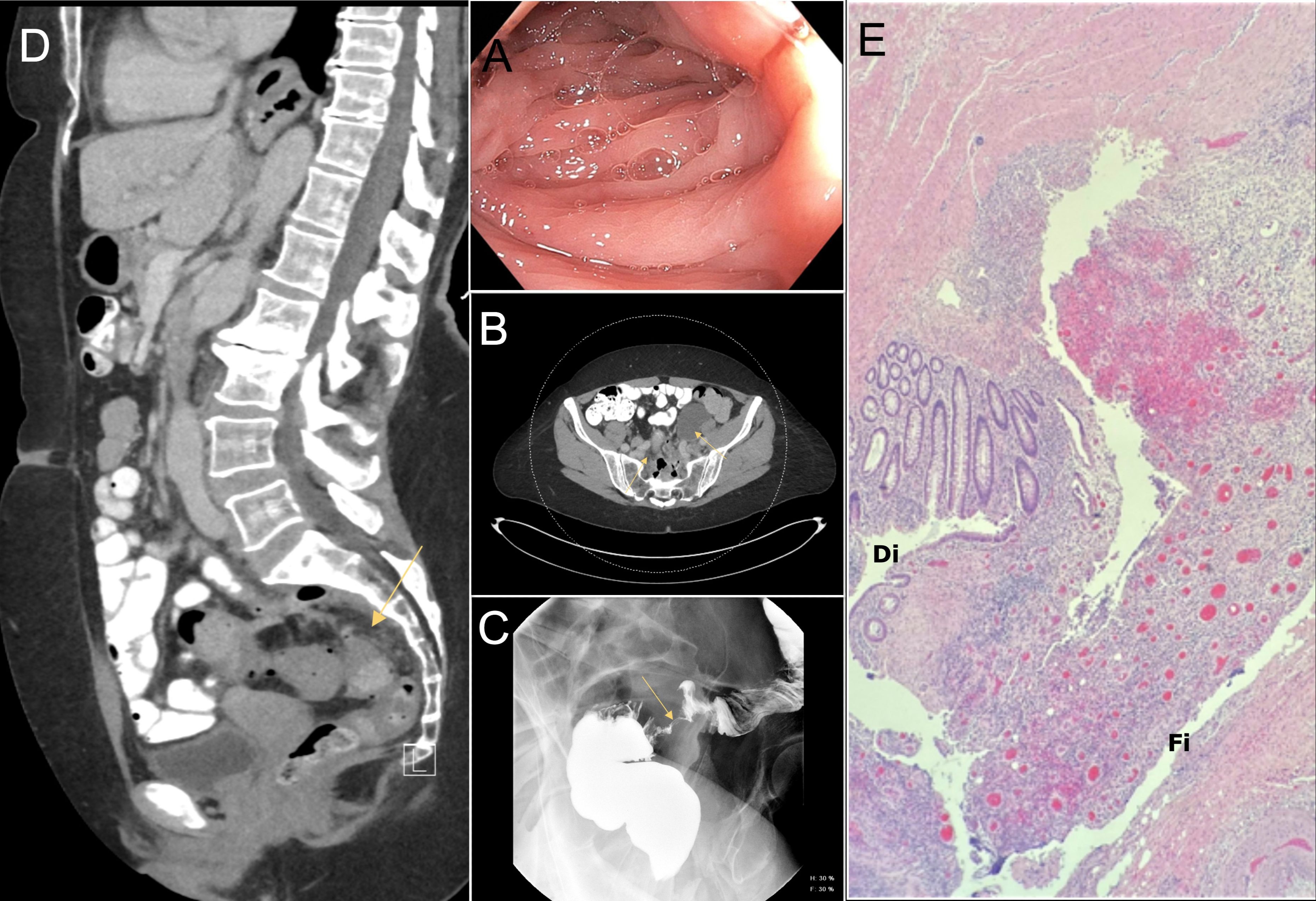Tuesday Poster Session
Category: Colon
P3154 - Incidental Diagnosis of Fistulizing and Stricturing Diverticulitis of the Sigmoid Colon: A Case Report of Asymptomatic Presentation
Tuesday, October 24, 2023
10:30 AM - 4:00 PM PT
Location: Exhibit Hall

Has Audio
- KK
Kinnari R. Kher, MD
Mount Auburn Hospital
Cambridge, MA
Presenting Author(s)
Abhishek Shahapurkar, MD, Irina Dubinchik, MD, William Denison, MD, Deborah Schnipper, MD, Kinnari Kher, MD
Mount Auburn Hospital, Cambridge, MA
Introduction: The incidence of diverticular disease has increased in the United States. In male patients with sigmoid diverticular disease, 2.2% have a stricture, and 8% have a fistula; rates for females are 4% and 7.8%, respectively. Fistulizing diverticulitis of the sigmoid colon usually presents with nausea, vomiting, abdominal pain, fevers, and constipation or diarrhea. This case report describes an asymptomatic patient with sigmoid diverticulitis and multiple fistulae who presented for a routine screening colonoscopy.
Case Description/Methods: We report a case of a 62-year-old female who presented for a screening colonoscopy and was found to have an incidental severe sigmoid colon stricture, confirmed by barium enema. Further work-up with CT imaging revealed sigmoid colon diverticulitis with fluid collections in the pelvis and presacral space. A significant amount of fluid in the left hemipelvis encircled the left ureter and left fallopian tube, causing left hydroureter and left hydrosalpinx. The patient was otherwise healthy and had no history of gastrointestinal symptoms, pelvic radiation, or obstetric trauma. She underwent a joint procedure with Colorectal Surgery and Urology and was found to have perforated sigmoid diverticulitis with fistulization to the presacral space. A second fistula from the presacral space to the terminal ileum was also noted. Robotic sigmoid colectomy and low anterior resection were performed, and the terminal ileum fistula was repaired. A left ureteric stent was placed for the hydroureter. Pathologic examination showed extensive diverticular disease with focal acute, subacute, and chronic inflammation and fistulous tract formation without evidence of malignancy or Crohn’s disease.
Discussion: Complicated diverticulitis of the sigmoid colon, such as with fistula formation, often presents with severe or prolonged abdominal symptoms. Multiple fistulae can cause complications such as peritonitis and pelvic abscesses. Strictures encountered during colonoscopy should undergo prompt additional evaluation as they may reveal underlying silent complications of common conditions like diverticulitis, Crohn’s disease, or malignancy. This case highlights the atypical asymptomatic presentation of complicated diverticular disease. Clinicians should be aware of subtle or asymptomatic diverticular complications, even if patients do not report any symptoms.

Disclosures:
Abhishek Shahapurkar, MD, Irina Dubinchik, MD, William Denison, MD, Deborah Schnipper, MD, Kinnari Kher, MD. P3154 - Incidental Diagnosis of Fistulizing and Stricturing Diverticulitis of the Sigmoid Colon: A Case Report of Asymptomatic Presentation, ACG 2023 Annual Scientific Meeting Abstracts. Vancouver, BC, Canada: American College of Gastroenterology.
Mount Auburn Hospital, Cambridge, MA
Introduction: The incidence of diverticular disease has increased in the United States. In male patients with sigmoid diverticular disease, 2.2% have a stricture, and 8% have a fistula; rates for females are 4% and 7.8%, respectively. Fistulizing diverticulitis of the sigmoid colon usually presents with nausea, vomiting, abdominal pain, fevers, and constipation or diarrhea. This case report describes an asymptomatic patient with sigmoid diverticulitis and multiple fistulae who presented for a routine screening colonoscopy.
Case Description/Methods: We report a case of a 62-year-old female who presented for a screening colonoscopy and was found to have an incidental severe sigmoid colon stricture, confirmed by barium enema. Further work-up with CT imaging revealed sigmoid colon diverticulitis with fluid collections in the pelvis and presacral space. A significant amount of fluid in the left hemipelvis encircled the left ureter and left fallopian tube, causing left hydroureter and left hydrosalpinx. The patient was otherwise healthy and had no history of gastrointestinal symptoms, pelvic radiation, or obstetric trauma. She underwent a joint procedure with Colorectal Surgery and Urology and was found to have perforated sigmoid diverticulitis with fistulization to the presacral space. A second fistula from the presacral space to the terminal ileum was also noted. Robotic sigmoid colectomy and low anterior resection were performed, and the terminal ileum fistula was repaired. A left ureteric stent was placed for the hydroureter. Pathologic examination showed extensive diverticular disease with focal acute, subacute, and chronic inflammation and fistulous tract formation without evidence of malignancy or Crohn’s disease.
Discussion: Complicated diverticulitis of the sigmoid colon, such as with fistula formation, often presents with severe or prolonged abdominal symptoms. Multiple fistulae can cause complications such as peritonitis and pelvic abscesses. Strictures encountered during colonoscopy should undergo prompt additional evaluation as they may reveal underlying silent complications of common conditions like diverticulitis, Crohn’s disease, or malignancy. This case highlights the atypical asymptomatic presentation of complicated diverticular disease. Clinicians should be aware of subtle or asymptomatic diverticular complications, even if patients do not report any symptoms.

Figure: A: Colonoscopy showing sigmoid colon stricture.
B: CT scan axial view, arrows showing left hydrosalpinx and fluid in presacral space.
C: Barium enema, arrow showing sigmoid stricture.
D: CT scan sagittal view, arrow showing fluid in the presacral space.
E: Histopathology slide showing diverticulum (Di) and fistula (Fi); Hematoxylin-eosin, magnification x20.
B: CT scan axial view, arrows showing left hydrosalpinx and fluid in presacral space.
C: Barium enema, arrow showing sigmoid stricture.
D: CT scan sagittal view, arrow showing fluid in the presacral space.
E: Histopathology slide showing diverticulum (Di) and fistula (Fi); Hematoxylin-eosin, magnification x20.
Disclosures:
Abhishek Shahapurkar indicated no relevant financial relationships.
Irina Dubinchik indicated no relevant financial relationships.
William Denison indicated no relevant financial relationships.
Deborah Schnipper indicated no relevant financial relationships.
Kinnari Kher indicated no relevant financial relationships.
Abhishek Shahapurkar, MD, Irina Dubinchik, MD, William Denison, MD, Deborah Schnipper, MD, Kinnari Kher, MD. P3154 - Incidental Diagnosis of Fistulizing and Stricturing Diverticulitis of the Sigmoid Colon: A Case Report of Asymptomatic Presentation, ACG 2023 Annual Scientific Meeting Abstracts. Vancouver, BC, Canada: American College of Gastroenterology.

